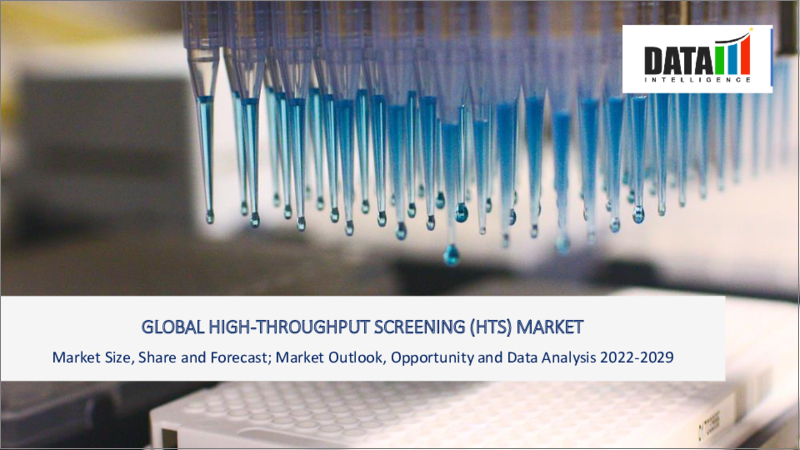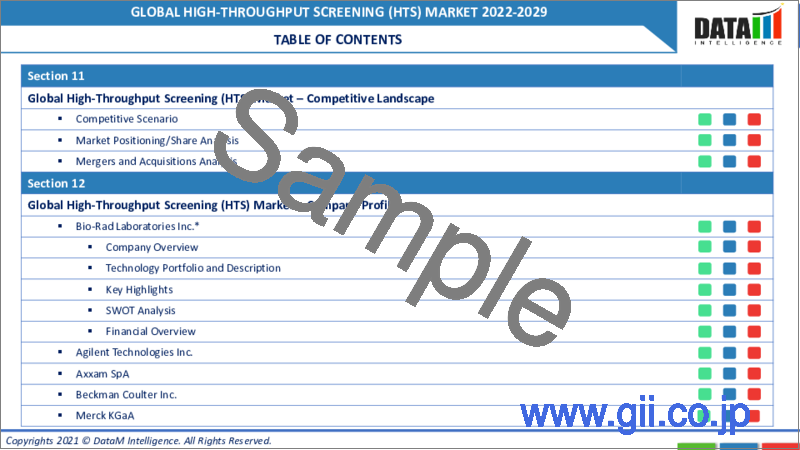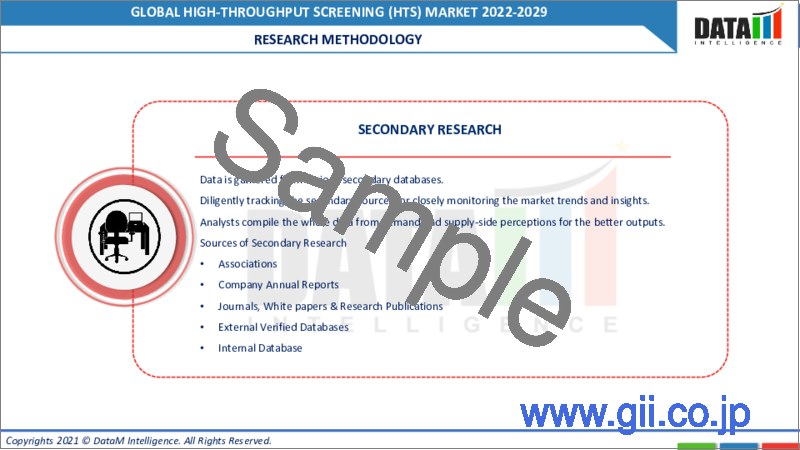|
|
市場調査レポート
商品コード
1077219
ハイスループットスクリーニング(HTS)の世界市場 - 2022年~2029年Global High-Throughput Screening (HTS) Market - 2022-2029 |
||||||
|
● お客様のご希望に応じて、既存データの加工や未掲載情報(例:国別セグメント)の追加などの対応が可能です。 詳細はお問い合わせください。 |
|||||||
| ハイスループットスクリーニング(HTS)の世界市場 - 2022年~2029年 |
|
出版日: 2022年05月19日
発行: DataM Intelligence
ページ情報: 英文 185 Pages
納期: 約2営業日
|
- 全表示
- 概要
- 目次
目次
第1章 ハイスループットスクリーニング(HTS)市場の調査手法と範囲
第2章 ハイスループットスクリーニング(HTS)市場-市場の定義と概要
第3章 ハイスループットスクリーニング(HTS)市場-エグゼクティブサマリー
- 技術別市場内訳
- 用途市場内訳
- エンドユーザー別市場内訳
- 地域別市場内訳
第4章 ハイスループットスクリーニング(HTS)市場力学
- 市場に影響を与える要因
- 促進要因
- 抑制要因
- 市場機会
- 影響分析
第5章 ハイスループットスクリーニング(HTS)市場-業界分析
- ポーターのファイブフォース分析
- サプライチェーン分析
- 価格分析
- 規制分析
- アンメットニーズ
第6章 ハイスループットスクリーニング(HTS)市場-COVID-19分析
第7章 ハイスループットスクリーニング(HTS)市場-技術別
- イントロダクション
- 市場規模分析、および前年比成長分析(%)、技術別
- 市場魅力指数、技術別
- 超ハイスループットスクリーニング
- セルベースアッセイ
- ラボオンチップ
- ラベルフリー技術
- その他
第8章 ハイスループットスクリーニング(HTS)市場-用途別
- イントロダクション
- 市場規模分析、および前年比成長分析(%)、用途別
- 市場魅力指数、用途別
- ターゲットの識別
- 一次スクリーニング
- 毒物学
- その他
第9章 ハイスループットスクリーニング(HTS)市場-エンドユーザー別
- イントロダクション
- 市場規模分析、および前年比成長分析(%)、エンドユーザー別
- 市場魅力指数、エンドユーザー別
- 医薬品およびバイオ技術
- イントロダクション
- 市場規模分析、100万米ドル(2020年~2029年)、および対前年比成長分析(%)(2021年~2029年)
- 学術研究機関
- その他
第10章 ハイスループットスクリーニング(HTS)市場-地域別
- イントロダクション
- 市場規模分析、100万米ドル(2020年~2029年)、および対前年比成長分析(%)(2021年~2029年)、地域別
- 市場魅力指数、地域別
- 北米
- 欧州
- 南米
- アジア太平洋
- 中東・アフリカ
第11章 ハイスループットスクリーニング(HTS)市場の競合情勢
- 主な発展と戦略
- 企業シェア分析
- 製品のベンチマーク
第12章 ハイスループットスクリーニング(HTS)市場-企業プロファイル
- Bio-Rad Laboratories Inc.
- Agilent Technologies Inc.
- Axxam SpA
- Beckman Coulter Inc.
- Merck KGaA
- PerkinElmer Inc.
- Tecan Group Ltd
- Thermo Fisher Scientific Inc.
- Hamilton Company
- Aurora Biomed
第13章 ハイスループットスクリーニング(HTS)市場-DataM
Market Overview
The global high-throughput screening (HTS) market size was valued at US$ XX million in 2021 and is estimated to reach US$ XX million by 2029, growing at a CAGR of XX % during the forecast period (2022-2029).
High throughput screening rapidly tests thousands to millions of samples for biological activity at the model organism, cellular, pathway, or molecular level using automated equipment (HTS).
Market Dynamics
The factors influencing the global high-throughput screening (HTS) market are the increasing advantages, and the growing technological advancements are expected to drive the market growth.
The increasing advantages of high-throughput screening (HTS) are expected to drive market growth in the forecast period
HTS is required to test the compounds in functional or binding assays simultaneously. HTS is used in the drug discovery process to quickly screen the biochemical activity of many drug-like compounds. A plate, or tray, is at the heart of the HTS system, consisting of tiny wells into which assay reagents and samples are deposited and their reactions monitored. In a single day, HTS systems can evaluate tens of thousands, if not hundreds of thousands, of compounds. The amount of data for each experiment grows as the throughput grows, and scientists analyse and derive results from large amounts of data. Because of the large number of samples processed and the large amount of data generated, extensive automation techniques are required to streamline operations. One of the benefits of HTS is that it can be used even if the structure of a target protein is unknown.
Furthermore, HTS can be used to identify inducible pockets in protein-protein interfaces and allosteric modulators. The primary goal of the HTS technique is to accelerate drug discovery by screening large compound libraries at a rate of a few thousand compounds per day or week. Because parallel and combinatorial chemical synthesis generate many novel compounds. HTS's effectiveness in identifying target-specific compounds can be attributed to its laser-like focus on a single mechanism. The evolution of this technology is closely linked to changes in chemical synthesis strategy. Many scientists are interested in combinatorial chemistry because of the large number of compounds that can be produced and the ability to test many compounds in a short period. Various techniques such as fluorescence resonance energy transfer (FRET) and homogeneous time-resolved fluorescence (HTRF) are available for compound identification.
Limitations associated with high-throughput screening (HTS) are expected to hamper the market growth
Automation necessitates large investments in machinery and supporting infrastructure, which is prohibitive for small and medium-sized research institutes. As a result, the high costs associated with automation techniques may stifle market growth. Moreover, the low hit rate due to incompatible libraries and the potential for false positives are both drawbacks. One of the most successful examples of identifying PPI inhibitors through HTS is the discovery of nutlins and benzodiazepinediones as p53-MDM2 inhibitors. RG7112, a nutlin derivative, is currently in Phase I clinical trials for the treatment of leukaemia and solid tumours. Hence, the limitations are expected to hamper the market growth.
COVID-19 Impact Analysis
Several established pharmaceutical and biopharmaceutical companies have stepped forward to develop treatments following the World Health Organization's declaration of the COVID-19 outbreak as a pandemic. In just a few weeks, scientists discovered a list of molecules that target COVID-19. There are currently 79 vaccine candidates in development, 20 of which are in stage 3 clinical trials. In several countries, 11 vaccines have been approved to date. Four promising drugs have been repurposed against COVID-19 (Remdesivir, Chloroquine & Hydroxychloroquine, Lopinavir & Ritonavir, and Lopinavir with Ritonavir plus Interferon beta-1a). The WHO announced on March 24, 2020, that it had started a global mega trial of the four most promising COVID-19 drugs. Furthermore, researchers in several countries are examining the potential of various existing drugs to treat COVID-19. With high-throughput screening products being used for drug discovery, the market is expected to grow due to increased drug discovery projects for the development of COVID-19 treatments.
Segment Analysis
Based on end-user, the pharmaceutical and biotechnology segment is expected to dominate the market growth
Most large and small biotechnology and pharmaceutical companies are focusing on developing novel molecules to treat a variety of chronic conditions to gain a sustainable competitive advantage. Furthermore, new drug therapy approvals by the FDA's Center for Drug Evaluation and Research (CDER) aided a wide range of patients suffering from various medical conditions. The adoption of automated high-throughput screening techniques to screen massive chemical and biomarker libraries generated during the research processes has resulted from the need for rapid and precise screening of several target molecules during the drug discovery and development phases. Because an automated
HTS system can test 10,000 to 100,000 target compounds per day, and uHTS can test more than 100,000 compounds per day, their use in the drug discovery and development process is growing. Drug discovery aims to find new antitumoral drugs, which is a highly complex and multidisciplinary process. The current drug discovery protocols' screening attrition rate suggests that one marketable drug emerges from approximately one million screened compounds. As a result, there is a push to screen larger libraries to keep the pipeline going and develop High Throughput Screening. HTS refers to specific developments in laboratory automation that allow for the collection of large amounts of experimental data in a short amount of time. Hundreds of thousands of compounds can be tested per day using HTS. Hence, the use of HTS in the pharmaceutical and biotechnology industry is expected to drive market growth.
Geographical Analysis
North America region is expected to hold the largest market share in the global high-throughput screening (HTS) market
The factors driving the growth of the HTS market in this region include rising disease prevalence, rising pharmaceutical R&D expenditure, and the presence of major players. For instance, PerkinElmer, Inc. is a multinational corporation based in the United States. The company's Ultra-High Throughput Screening Platform with Multiple Modules is a one-of-a-kind, multimodule system that combines ultra-high-throughput screening and high content screening (HCS) into a single platform. Hence, the growing presence of key players in this region is expected to boost the market growth.
Competitive Landscape
The global high-throughput screening (HTS) market is moderately competitive with mergers, acquisitions, and product launches. Some of the key players in the market are Agilent Technologies Inc., Axxam SpA, Beckman Coulter Inc., Bio-Rad Laboratories Inc., Merck KGaA, PerkinElmer Inc., Tecan Group Ltd, Hamilton Company, Aurora Biomed, and Thermo Fisher Scientific Inc.
Bio-Rad Laboratories Inc.
Overview: Bio-Rad Laboratories, Inc. is based in the United States that develops and manufactures specialised technological products for the life science research and clinical diagnostics markets. The company was Founded in 1952.
Product Portfolio: The ZE5 Cell Analyzer is a high-performance flow cytometer that can be automated. It offers high-throughput screening and high-parameter cell analysis.
Key Development: On 30th June 2020, Bio-Rad Laboratories, Inc. partners with Seegene, Inc. to develop and commercialise infectious disease molecular diagnostic products, as well as to expand its presence in the high-throughput screening market.
Why Purchase the Report?
Visualize the composition of the global high-throughput screening (HTS) market segmentation by technology, by application, and end-user highlighting the key commercial assets and players.
Identify commercial opportunities in global high-throughput screening (HTS) market by analyzing trends and co-development deals.
Excel data sheet with thousands of data points of global high-throughput screening (HTS) market- level 4/5 segmentation.
PDF report with the most relevant analysis cogently put together after exhaustive qualitative interviews and in-depth market study.
Product mapping in excel for the key product of all major market players
The global high-throughput screening (HTS) market report would provide an access to an approx. 45+market data table, 40+figures and 185 pages.
Target Audience
Service Providers/ Buyers
Industry Investors/Investment Bankers
Education & Research Institutes
Research Professionals
Emerging Companies
Manufacturers
Table of Contents
1. High-Throughput Screening (HTS) Market Methodology and Scope
- 1.1. Research Methodology
- 1.2. Research Objective and Scope of the Report
2. High-Throughput Screening (HTS) Market- Market Definition and Overview
3. High-Throughput Screening (HTS) Market- Executive Summary
- 3.1. Market Snippet By Technology
- 3.2. Market Snippet By Application
- 3.3. Market Snippet By End User
- 3.4. Market Snippet By Region
4. High-Throughput Screening (HTS) Market-Market Dynamics
- 4.1. Market Impacting Factors
- 4.1.1. Drivers:
- 4.1.1.1. The increasing advantages of high-throughput screening (HTS)
- 4.1.2. Restraints:
- 4.1.2.1. Limitations associated with high-throughput screening (HTS)
- 4.1.3. Opportunity
- 4.1.4. Impact Analysis
- 4.1.1. Drivers:
5. High-Throughput Screening (HTS) Market- Industry Analysis
- 5.1. Porter's Five Forces Analysis
- 5.2. Supply Chain Analysis
- 5.3. Pricing Analysis
- 5.4. Regulatory Analysis
- 5.5. Unmet Needs
6. High-Throughput Screening (HTS) Market- COVID-19 Analysis
- 6.1. Analysis of Covid-19 on the Market
- 6.1.1. Before COVID-19 Market Scenario
- 6.1.2. Present COVID-19 Market Scenario
- 6.1.3. After COVID-19 or Future Scenario
- 6.2. Pricing Dynamics Amid Covid-19
- 6.3. Demand-Supply Spectrum
- 6.4. Government Initiatives Related to the Market During Pandemic
- 6.5. Manufacturers Strategic Initiatives
- 6.6. Conclusion
7. High-Throughput Screening (HTS) Market- By Technology
- 7.1. Introduction
- 7.2. Market Size Analysis, and Y-o-Y Growth Analysis (%), By Technology
- 7.3. Market Attractiveness Index, By Technology
- 7.3.1. Ultra-high-throughput Screening
- 7.3.1.1.1. Introduction
- 7.3.1.1.2. Market Size Analysis, US$ Mn, 2020-2029 and Y-o-Y Growth Analysis (%), 2021-2029
- 7.3.2. Cell-based Assays
- 7.3.3. Lab-on-a-chip
- 7.3.4. Label-free Technology
- 7.3.5. Others
- 7.3.1. Ultra-high-throughput Screening
8. High-Throughput Screening (HTS) Market-By Application
- 8.1. Introduction
- 8.2. Market Size Analysis, and Y-o-Y Growth Analysis (%), By Application
- 8.3. Market Attractiveness Index, By Application
- 8.3.1. Target Identification*
- 8.3.1.1.1. Introduction
- 8.3.1.1.2. Market Size Analysis, US$ Mn, 2020-2029 and Y-o-Y Growth Analysis (%), 2021-2029
- 8.3.2. Primary Screening
- 8.3.3. Toxicology
- 8.3.4. Other
- 8.3.1. Target Identification*
9. High-Throughput Screening (HTS) Market- By End User
- 9.1. Introduction
- 9.1.1. Market Size Analysis, and Y-o-Y Growth Analysis (%), By End User
- 9.1.2. Market Attractiveness Index, By End User
- 9.2. Pharmaceutical and Biotechnology *
- 9.2.1. Introduction
- 9.2.2. Market Size Analysis, US$ Million, 2020-2029 and Y-o-Y Growth Analysis (%), 2021-2029
- 9.3. Academia and Research Institutes
- 9.4. Other
10. High-Throughput Screening (HTS) Market- By Region
- 10.1. Introduction
- 10.1.1. Market Size Analysis, US$ Million, 2020-2029 and Y-o-Y Growth Analysis (%), 2021-2029, By Region
- 10.1.2. Market Attractiveness Index, By Region
- 10.2. North America
- 10.2.1. Introduction
- 10.2.2. Key Region-Specific Dynamics
- 10.2.3. Market Size Analysis, and Y-o-Y Growth Analysis (%), By Technology
- 10.2.4. Market Size Analysis, and Y-o-Y Growth Analysis (%), By Application
- 10.2.5. Market Size Analysis, and Y-o-Y Growth Analysis (%), By End User
- 10.2.6. Market Size Analysis, and Y-o-Y Growth Analysis (%), By Country
- 10.2.6.1. U.S.
- 10.2.6.2. Canada
- 10.2.6.3. Mexico
- 10.3. Europe
- 10.3.1. Introduction
- 10.3.2. Key Region-Specific Dynamics
- 10.3.3. Market Size Analysis, and Y-o-Y Growth Analysis (%), By Technology
- 10.3.4. Market Size Analysis, and Y-o-Y Growth Analysis (%), By Application
- 10.3.5. Market Size Analysis, and Y-o-Y Growth Analysis (%), By End User
- 10.3.6. Market Size Analysis, and Y-o-Y Growth Analysis (%), By Country
- 10.3.6.1. Germany
- 10.3.6.2. U.K.
- 10.3.6.3. France
- 10.3.6.4. Italy
- 10.3.6.5. Spain
- 10.3.6.6. Rest of Europe
- 10.4. South America
- 10.4.1. Introduction
- 10.4.2. Key Region-Specific Dynamics
- 10.4.3. Market Size Analysis, and Y-o-Y Growth Analysis (%), By Technology
- 10.4.4. Market Size Analysis, and Y-o-Y Growth Analysis (%), By Application
- 10.4.5. Market Size Analysis, and Y-o-Y Growth Analysis (%), By End User
- 10.4.6. Market Size Analysis, and Y-o-Y Growth Analysis (%), By Country
- 10.4.6.1. Brazil
- 10.4.6.2. Argentina
- 10.4.6.3. Rest of South America
- 10.5. Asia Pacific
- 10.5.1. Introduction
- 10.5.2. Key Region-Specific Dynamics
- 10.5.3. Market Size Analysis, and Y-o-Y Growth Analysis (%), By Technology
- 10.5.4. Market Size Analysis, and Y-o-Y Growth Analysis (%), By Application
- 10.5.5. Market Size Analysis, and Y-o-Y Growth Analysis (%), By End User
- 10.5.6. Market Size Analysis, and Y-o-Y Growth Analysis (%), By Country
- 10.5.6.1. China
- 10.5.6.2. India
- 10.5.6.3. Japan
- 10.5.6.4. Australia
- 10.5.6.5. Rest of Asia Pacific
- 10.6. Middle East and Africa
- 10.6.1. Introduction
- 10.6.2. Key Region-Specific Dynamics
- 10.6.3. Market Size Analysis, and Y-o-Y Growth Analysis (%), By Technology
- 10.6.4. Market Size Analysis, and Y-o-Y Growth Analysis (%), By Application
- 10.6.5. Market Size Analysis, and Y-o-Y Growth Analysis (%), By End User
11. High-Throughput Screening (HTS) Market- Competitive Landscape
- 11.1. Key Developments and Strategies
- 11.2. Company Share Analysis
- 11.3. Product Benchmarking
12. High-Throughput Screening (HTS) Market- Company Profiles
- 12.1. Bio-Rad Laboratories Inc.*
- 12.1.1. Company Overview
- 12.1.2. Product Portfolio and Description
- 12.1.3. Key Highlights
- 12.1.4. Financial Overview
- 12.2. Agilent Technologies Inc.
- 12.3. Axxam SpA
- 12.4. Beckman Coulter Inc.
- 12.5. Merck KGaA
- 12.6. PerkinElmer Inc.
- 12.7. Tecan Group Ltd
- 12.8. Thermo Fisher Scientific Inc.
- 12.9. Hamilton Company
- 12.10. Aurora Biomed
LIST NOT EXHAUSTIVE
13. High-Throughput Screening (HTS) Market- DataM
- 13.1. Appendix
- 13.2. About Us and Services
- 13.3. Contact Us




